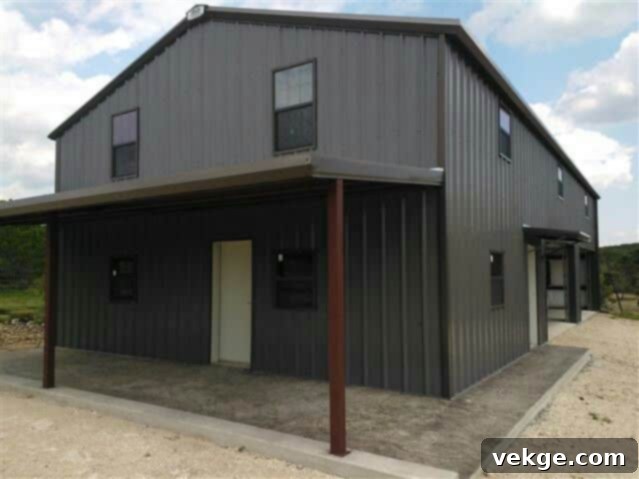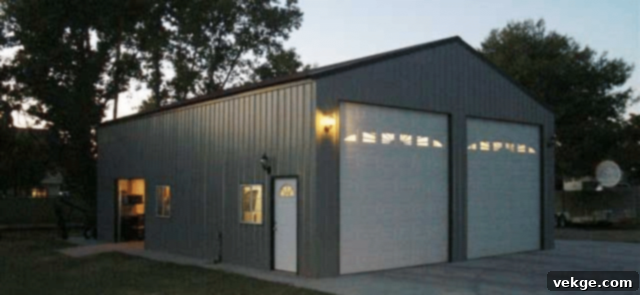Sustainable Storage Solutions: Why Metal Garages Are Key to Eco-Friendly Construction
In an era defined by a growing environmental consciousness, the fundamental principles of sustainable development, including eco-friendly solutions, are becoming paramount in every facet of life and the global economy. As industries and individuals seek ways to minimize their ecological footprint, the demand for innovative, sustainable infrastructure has surged. Constant upgrades and renovations in storage solutions are not just a trend but a necessity for modern living and commerce. This is precisely where high-quality metal garages shine, establishing themselves as the most sustainable and efficient alternative for meeting diverse storage and building needs.
Green and environmentally conscious metal garage buildings perfectly fulfill the increasing demand for sustainable construction and storage solutions. Over the past few decades, metal buildings have become remarkably more efficient, utilizing resources to their maximum potential while minimizing waste and environmental impact. Their inherent properties make them an ideal choice for anyone prioritizing long-term value, reduced environmental harm, and operational efficiency.
In today’s industrial world, the visible impacts of climate change and global warming are undeniably increasing, making the adoption of suitable mitigating measures critically important. One of the most significant environmental advantages of metal building structures is their inherent ability to minimize material waste throughout their lifecycle. Driven by a surging global demand for sustainable industrial metal and steel buildings, the necessity for green construction practices has reached unprecedented heights within the global market. Businesses, homeowners, and developers alike are recognizing the multifaceted benefits of integrating sustainable practices, with metal garages emerging as a leading solution.
The Imperative of Sustainability in Modern Construction

Incorporating sustainability into our building practices goes far beyond merely minimizing our environmental impact. It offers substantial long-term financial advantages, significantly enhances public health, and crucially protects vital resources for future generations to inherit. In the realm of metal garage buildings, sustainability corresponds to a comprehensive strategy of planning, developing, and managing structures with a strong emphasis on minimizing their ecological footprint, all while optimizing their socio-economic benefits.
This holistic approach entails generating less waste, utilizing eco-friendly and recycled materials, constructing energy-efficient devices and systems, and designing hygienic and comfortable interior spaces. The primary goals of sustainable building are clear: eliminating the loss of natural resources, drastically limiting greenhouse gas emissions, and boosting the health and well-being of building occupants and their surrounding communities. Consequently, sustainable construction has become a cornerstone for new construction projects and contemporary building designs worldwide, with steel structures playing a pivotal role in achieving these ambitious objectives.
Primary Benefits Associated with Adopting Sustainable Metal Garages
Choosing metal garage buildings is an excellent decision for environmentally conscious builders and homeowners alike. Here are the key benefits that underscore their appeal:
The Circular Economy Principle: Recycle, Reduce, and Reuse
Metal, particularly steel, boasts an unparalleled ability to be recycled easily and possesses remarkably high recovery rates during the renovation or demolition of steel buildings. Because they can be repeatedly recycled and reused throughout their extensive lifespan, metals like steel and aluminum, commonly utilized in metal garage buildings, are considered highly recyclable materials. This fundamental characteristic minimizes waste significantly and dramatically lowers the demand for new raw materials.
The act of recycling steel is a powerful environmental initiative, as it substantially reduces the need for new iron ore extraction, conserves immense amounts of energy during production, and leads to a considerable decline in greenhouse gas emissions associated with the manufacturing of new metal components for sustainable storage solutions. By opting for steel, you are actively participating in a circular economy, where resources are kept in use for as long as possible, extracting maximum value from them, then recovering and regenerating products and materials at the end of their service life.
Engineered for Endurance: Longevity and Durability at Its Best
Metal garage building structures are renowned for their exceptionally long lifespans and impressive resilience, making them a superior choice compared to structures made from other materials. Unlike buildings composed of wood or concrete, which may degrade or require frequent repairs, steel buildings demand less frequent replacement or renovation, significantly extending their useful life. This inherent durability translates directly into environmental benefits.
Over time, the cumulative environmental impact of material production, transportation, and disposal is drastically lessened due to the extended lifespan of metal structures. Steel’s resistance to rot, pests, warping, and mold means that the resources expended in its initial production are amortized over a much longer period. By choosing metal garage builders, the construction industry is actively adopting sustainable building techniques that prioritize long-term performance and minimal lifecycle environmental disruption. These structures are built to withstand harsh weather conditions, seismic activity, and general wear and tear, ensuring that your investment is both secure and sustainable for decades.
Maximizing Energy Efficiency for Lower Operational Costs
Structures made of steel are inherently designed to use very little energy, especially when paired with modern insulation techniques. Significant advancements in construction methods and insulation materials, such as rigid insulation, spray foam, and insulated metal panels, enable better thermal performance and dramatically lower energy usage for both heating and cooling. This translates into substantial reductions in a building’s lifetime carbon footprint and its operational energy consumption.
Efficient metal garage buildings can be designed with thermal breaks to prevent heat transfer, ensuring that interior temperatures remain stable regardless of external conditions. This not only reduces utility bills for heating and air conditioning but also creates a more comfortable internal environment. Furthermore, the reflective properties of some metal roofing materials can help to mitigate the urban heat island effect, further contributing to overall energy savings and environmental well-being.
Streamlined Construction: Reduction of Construction Waste
One of the most compelling advantages of metal garage buildings for sale is their construction methodology. These structures are fabricated using precision-engineered parts made off-site in a controlled factory environment and then assembled efficiently on-site. This method of precision prefabrication stands in stark contrast to traditional construction techniques, where much material is cut, shaped, and often wasted on-site.
The total construction waste produced throughout the building process is minimized due to this highly efficient, manufactured approach. Fewer off-cuts, less debris, and a more streamlined assembly process mean a smaller environmental footprint. Selecting steel for your construction project ensures that the building will be robust, strong, and durable, while simultaneously reducing material waste during construction and minimizing future maintenance costs. This approach offers exceptional resilience to environmental changes and represents a cleaner, more organized construction site, benefiting both workers and the surrounding environment.
Natural Resistance: A Healthier, Safer Structure
A key component of the sustainability of metal garage buildings is steel’s natural resilience to various environmental threats. Unlike wood, steel is impervious to mold, mildew, rot, and pest infestations such as termites and rodents. This inherent resistance eliminates the requirement for the particular chemical treatments and pesticides frequently needed in buildings with wood frames, thereby reducing the introduction of potentially harmful substances into the environment and improving indoor air quality.
Its moisture resistance prevents bacterial infestations that are detrimental to the health of its occupants and guarantees a long lifespan with minimal maintenance, further reducing the overall carbon footprint associated with repairs and replacements. This natural hardiness contributes significantly to creating healthier indoor environments and reducing reliance on chemical interventions, making steel structures a truly sustainable and safe choice.
Harnessing Renewable Energy: Maximizing True Potential with Solar Integration
Solar energy is the most abundant renewable resource available on this planet, and its optimal combination with metal garage buildings adds significantly to resource conservation and helps harness the maximum building capacity of any project. The robust and structurally sound frames of metal buildings are incredibly sturdy and can easily support the weight and integrity of solar panels, making them an ideal platform for renewable energy generation.
Integrating solar panels not only powers prefabricated structures, potentially making them net-zero energy buildings, but also substantially increases the value of your property and drastically lowers your energy costs. The average return on investment for solar panels is between 15% and 20%, and as conventional utility costs continue to ascend, so does the economic value and environmental benefit of solar energy. By utilizing the expansive, often unshaded roof surfaces of metal garages, owners can become active participants in the clean energy transition, reducing their dependence on fossil fuels and contributing to a healthier planet.
Superior Fire Resistance and Enhanced Safety
Since steel is a non-combustible material, buildings constructed with steel frames inherently possess greater protection from fires compared to structures made from flammable materials. This crucial feature significantly lowers potential environmental damage resulting from fires, especially in urban or ecologically sensitive settings, and drastically reduces the possibility of fires spreading. The integrity of steel structures remains largely intact even in extreme heat, allowing for safer evacuation and minimizing structural collapse.
This enhanced fire resistance also translates into lower insurance premiums for property owners and greater peace of mind. By choosing steel, you are investing in a building that offers a higher degree of safety and resilience against one of the most destructive natural and human-caused hazards, further cementing its position as a sustainable and responsible building choice.
Adaptability and Reuse: Future-Proofing Your Investment
Steel buildings are remarkably versatile and can be readily expanded, reconfigured, or even relocated to accommodate constantly changing needs. This inherent capacity for adaptation and modularity means that the structure can serve various purposes over its lifetime, from a simple storage unit to a sophisticated workshop, office, or even an additional living space. This adaptability significantly extends the lifespan of the building and demands minimal new construction, which in turn minimizes its environmental impact and helps to preserve valuable resources.
Unlike less flexible traditional constructions that might require complete demolition and rebuilding to meet new requirements, metal structures can be modified with relative ease. This ability to “future-proof” an investment by allowing for modifications rather than replacements is a cornerstone of sustainable development, ensuring that the initial embodied energy and resources are utilized for as long as possible.
Investing in a Sustainable Future with Metal Garages
The array of benefits associated with metal garages makes them an unparalleled choice for anyone committed to sustainable practices. From their remarkable recyclability and exceptional energy efficiency to their enduring durability and inherent resistance to environmental threats, these structures embody the principles of green construction. They address the urgent need for solutions that not only perform excellently but also actively contribute to a healthier planet and a more sustainable future.
By opting for metal garages, individuals and businesses are making a conscious decision to reduce their carbon footprint, minimize waste, and invest in infrastructure that offers long-term value and environmental responsibility. This commitment extends beyond mere compliance; it represents a proactive step towards building a resilient and eco-friendly future.
Conclusion
Incorporating metal garage buildings into modern building design and operational strategies is a critical step towards supporting sustainable development. These structures guarantee long-term energy efficiency, significantly lower carbon footprints, and exceptional resource conservation. To effectively achieve sustainability goals and mitigate the accelerating challenges of climate change, it is becoming increasingly essential for building projects worldwide to utilize sustainable metal garage buildings as an integral part of the global initiative towards cleaner energy transitions and responsible resource management.
Given its unparalleled resilience, superior energy efficiency, remarkable adaptability, significantly decreased construction waste, and generally lower life cycle environmental effect, metal garage buildings offer substantial ecological and economic advantages. It stands as one of the most desirable and responsible options for environmentally conscious building approaches that strive to minimize the use of non-renewable resources and mitigate adverse environmental impacts. Choosing metal garages is not just a smart construction decision; it is an investment in a greener, more sustainable future for everyone.
